RMIT Gene Technologies: Chemical Production Reprogramming
VerifiedAdded on 2023/06/09
|7
|1557
|253
Project
AI Summary
This project focuses on genetically reprogramming plants to enhance the production of a valuable chemical, aiming to shift production from flowers to leaves for increased yield and commercial viability. The assignment details the design of transgenes, including promoter, coding, and terminator regions, for the production of the target chemical in leaves. It describes the design of a suitable vector containing the transgenes, along with strategies for transformation, generation, and selection of transgenic plants. The project also outlines methods to confirm the expression of the transgene and the production of the desired chemical X, including ELISA and PCR techniques. The goal is to develop a sustainable and efficient method for large-scale production of the chemical, addressing the limitations of seasonal and low flower production.
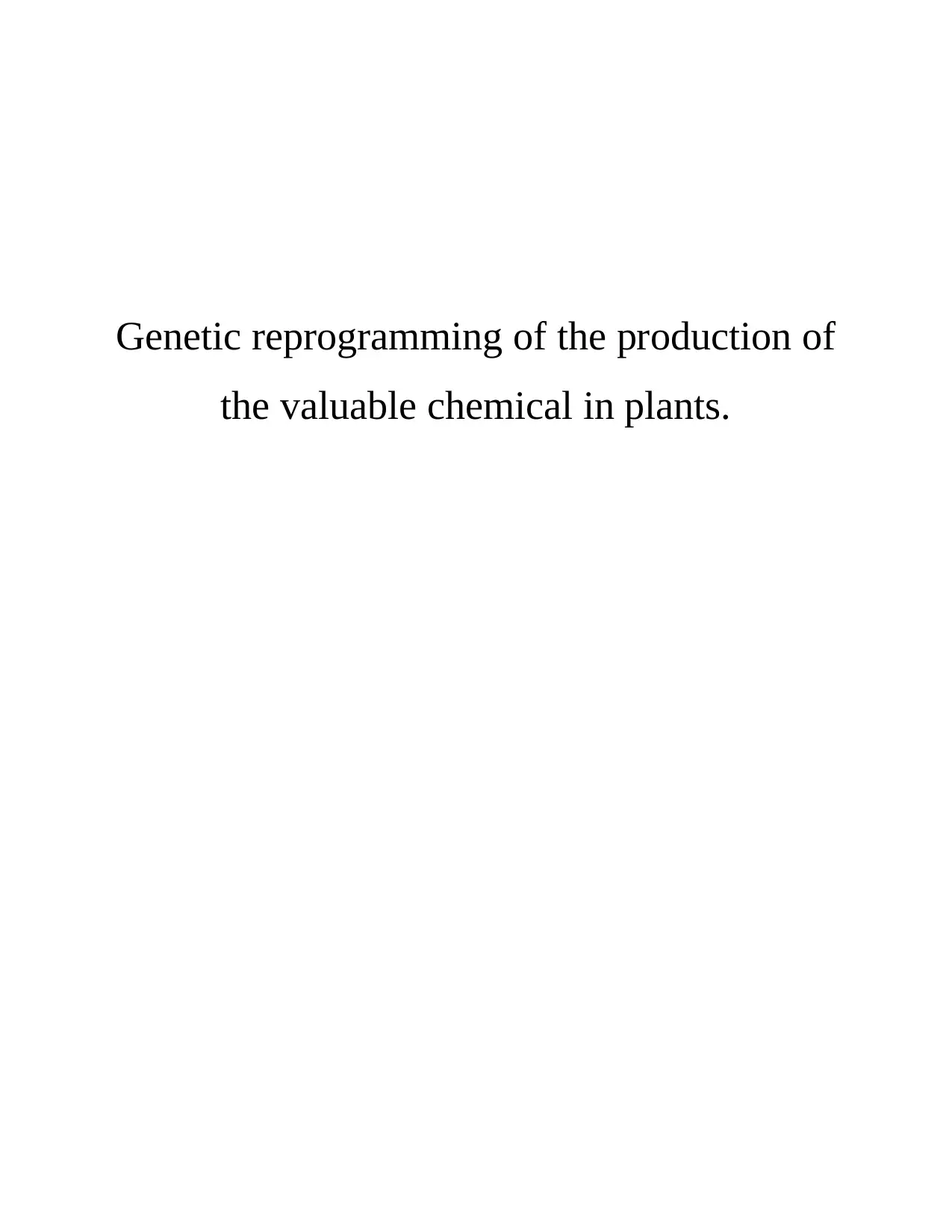
Genetic reprogramming of the production of
the valuable chemical in plants.
the valuable chemical in plants.
Paraphrase This Document
Need a fresh take? Get an instant paraphrase of this document with our AI Paraphraser
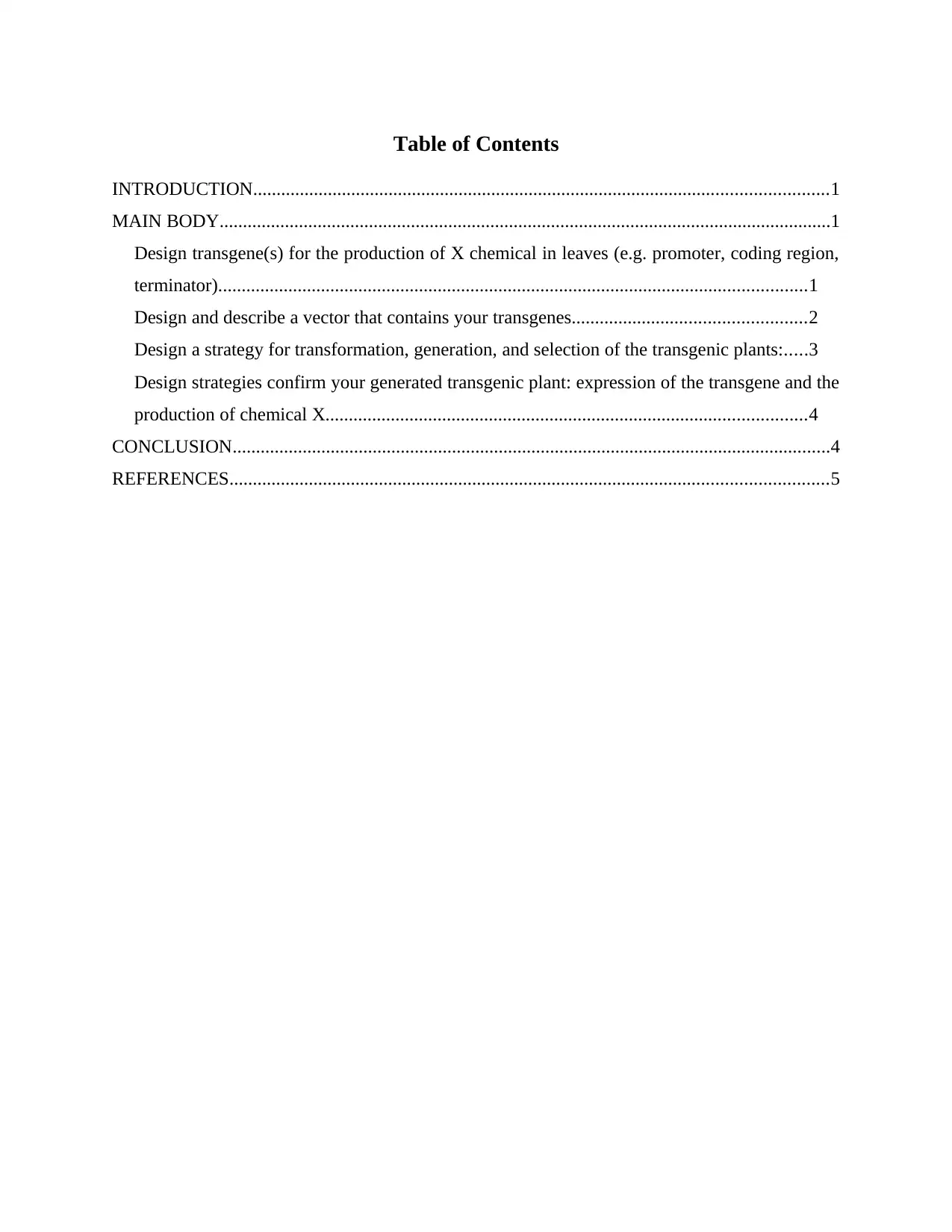
Table of Contents
INTRODUCTION...........................................................................................................................1
MAIN BODY...................................................................................................................................1
Design transgene(s) for the production of X chemical in leaves (e.g. promoter, coding region,
terminator)..............................................................................................................................1
Design and describe a vector that contains your transgenes..................................................2
Design a strategy for transformation, generation, and selection of the transgenic plants:.....3
Design strategies confirm your generated transgenic plant: expression of the transgene and the
production of chemical X.......................................................................................................4
CONCLUSION................................................................................................................................4
REFERENCES................................................................................................................................5
INTRODUCTION...........................................................................................................................1
MAIN BODY...................................................................................................................................1
Design transgene(s) for the production of X chemical in leaves (e.g. promoter, coding region,
terminator)..............................................................................................................................1
Design and describe a vector that contains your transgenes..................................................2
Design a strategy for transformation, generation, and selection of the transgenic plants:.....3
Design strategies confirm your generated transgenic plant: expression of the transgene and the
production of chemical X.......................................................................................................4
CONCLUSION................................................................................................................................4
REFERENCES................................................................................................................................5
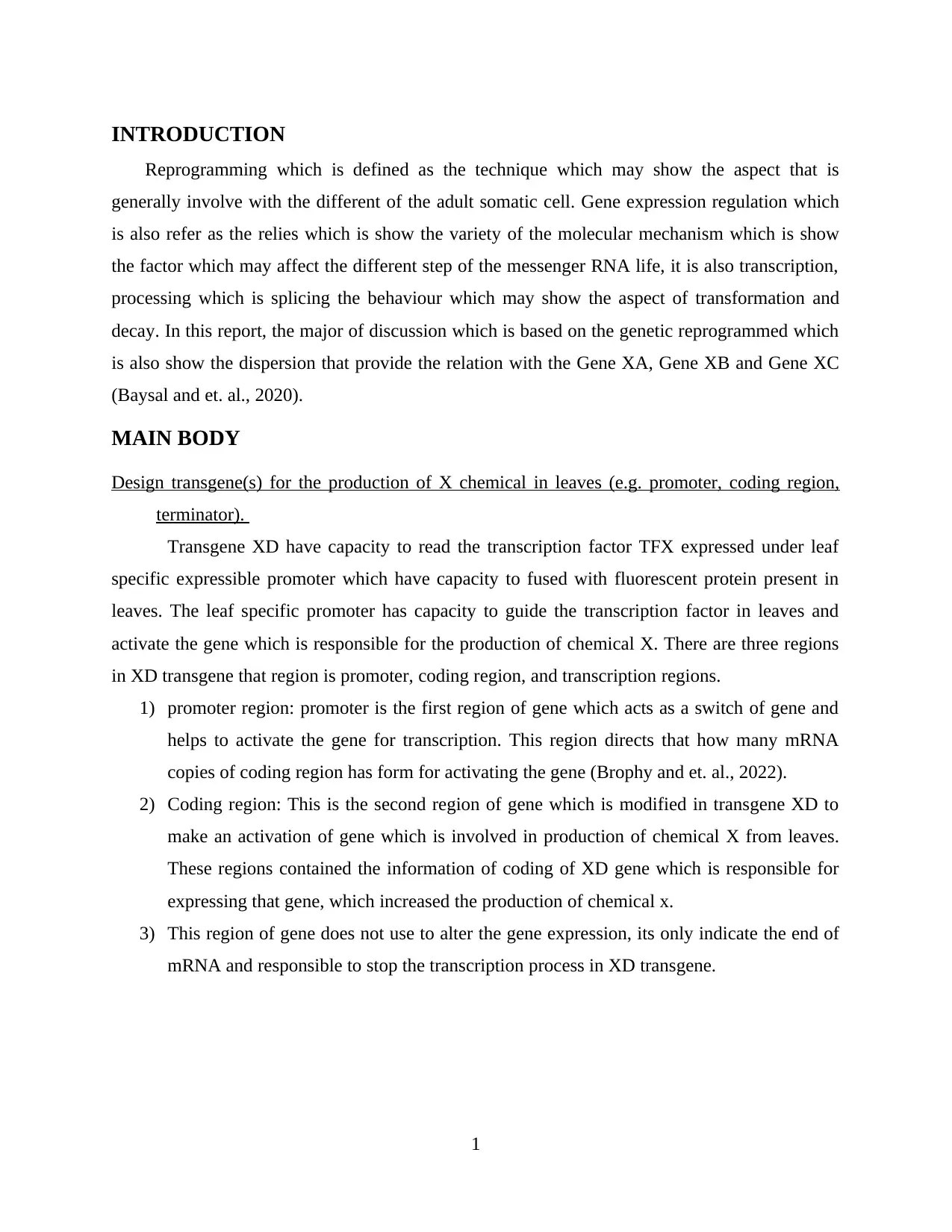
INTRODUCTION
Reprogramming which is defined as the technique which may show the aspect that is
generally involve with the different of the adult somatic cell. Gene expression regulation which
is also refer as the relies which is show the variety of the molecular mechanism which is show
the factor which may affect the different step of the messenger RNA life, it is also transcription,
processing which is splicing the behaviour which may show the aspect of transformation and
decay. In this report, the major of discussion which is based on the genetic reprogrammed which
is also show the dispersion that provide the relation with the Gene XA, Gene XB and Gene XC
(Baysal and et. al., 2020).
MAIN BODY
Design transgene(s) for the production of X chemical in leaves (e.g. promoter, coding region,
terminator).
Transgene XD have capacity to read the transcription factor TFX expressed under leaf
specific expressible promoter which have capacity to fused with fluorescent protein present in
leaves. The leaf specific promoter has capacity to guide the transcription factor in leaves and
activate the gene which is responsible for the production of chemical X. There are three regions
in XD transgene that region is promoter, coding region, and transcription regions.
1) promoter region: promoter is the first region of gene which acts as a switch of gene and
helps to activate the gene for transcription. This region directs that how many mRNA
copies of coding region has form for activating the gene (Brophy and et. al., 2022).
2) Coding region: This is the second region of gene which is modified in transgene XD to
make an activation of gene which is involved in production of chemical X from leaves.
These regions contained the information of coding of XD gene which is responsible for
expressing that gene, which increased the production of chemical x.
3) This region of gene does not use to alter the gene expression, its only indicate the end of
mRNA and responsible to stop the transcription process in XD transgene.
1
Reprogramming which is defined as the technique which may show the aspect that is
generally involve with the different of the adult somatic cell. Gene expression regulation which
is also refer as the relies which is show the variety of the molecular mechanism which is show
the factor which may affect the different step of the messenger RNA life, it is also transcription,
processing which is splicing the behaviour which may show the aspect of transformation and
decay. In this report, the major of discussion which is based on the genetic reprogrammed which
is also show the dispersion that provide the relation with the Gene XA, Gene XB and Gene XC
(Baysal and et. al., 2020).
MAIN BODY
Design transgene(s) for the production of X chemical in leaves (e.g. promoter, coding region,
terminator).
Transgene XD have capacity to read the transcription factor TFX expressed under leaf
specific expressible promoter which have capacity to fused with fluorescent protein present in
leaves. The leaf specific promoter has capacity to guide the transcription factor in leaves and
activate the gene which is responsible for the production of chemical X. There are three regions
in XD transgene that region is promoter, coding region, and transcription regions.
1) promoter region: promoter is the first region of gene which acts as a switch of gene and
helps to activate the gene for transcription. This region directs that how many mRNA
copies of coding region has form for activating the gene (Brophy and et. al., 2022).
2) Coding region: This is the second region of gene which is modified in transgene XD to
make an activation of gene which is involved in production of chemical X from leaves.
These regions contained the information of coding of XD gene which is responsible for
expressing that gene, which increased the production of chemical x.
3) This region of gene does not use to alter the gene expression, its only indicate the end of
mRNA and responsible to stop the transcription process in XD transgene.
1
⊘ This is a preview!⊘
Do you want full access?
Subscribe today to unlock all pages.

Trusted by 1+ million students worldwide
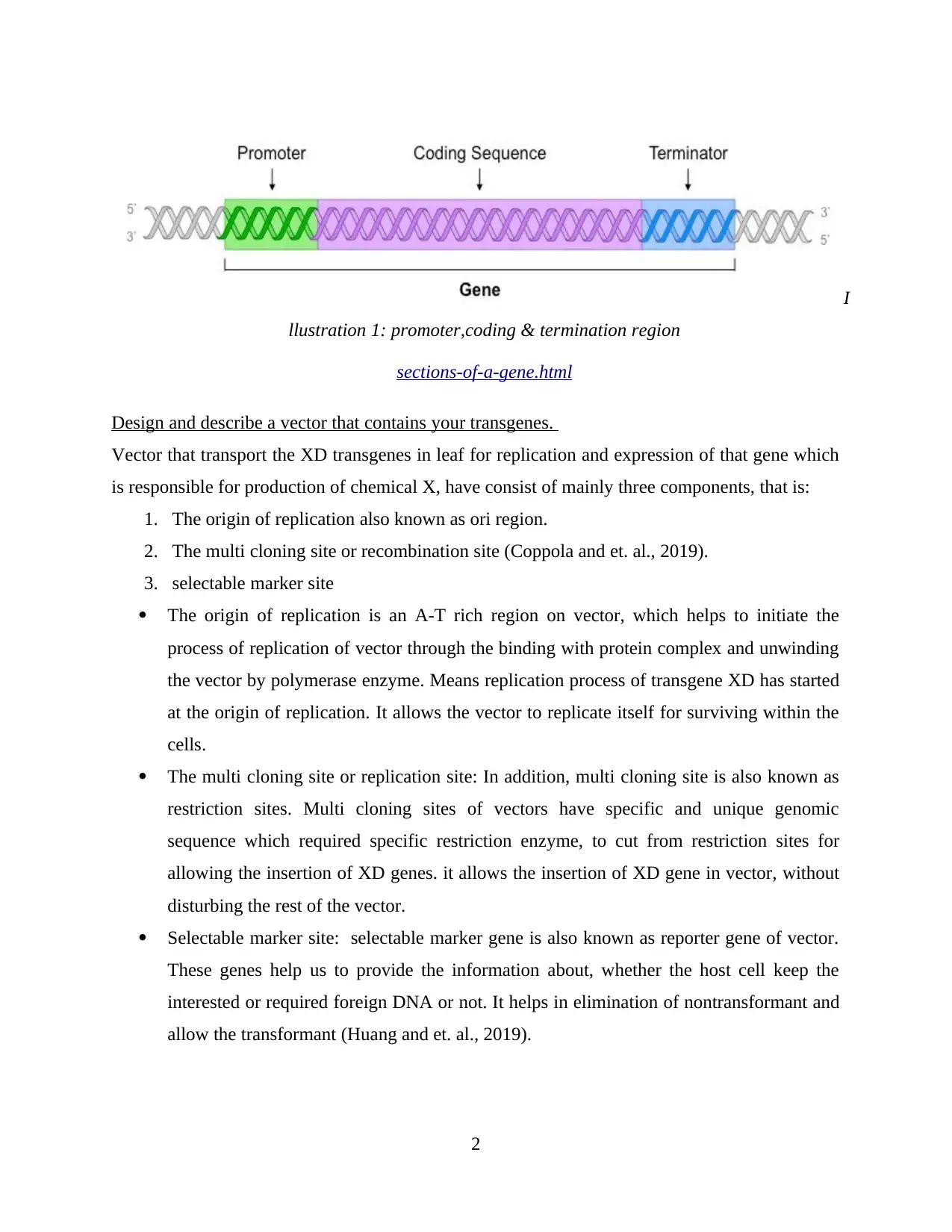
Design and describe a vector that contains your transgenes.
Vector that transport the XD transgenes in leaf for replication and expression of that gene which
is responsible for production of chemical X, have consist of mainly three components, that is:
1. The origin of replication also known as ori region.
2. The multi cloning site or recombination site (Coppola and et. al., 2019).
3. selectable marker site
The origin of replication is an A-T rich region on vector, which helps to initiate the
process of replication of vector through the binding with protein complex and unwinding
the vector by polymerase enzyme. Means replication process of transgene XD has started
at the origin of replication. It allows the vector to replicate itself for surviving within the
cells.
The multi cloning site or replication site: In addition, multi cloning site is also known as
restriction sites. Multi cloning sites of vectors have specific and unique genomic
sequence which required specific restriction enzyme, to cut from restriction sites for
allowing the insertion of XD genes. it allows the insertion of XD gene in vector, without
disturbing the rest of the vector.
Selectable marker site: selectable marker gene is also known as reporter gene of vector.
These genes help us to provide the information about, whether the host cell keep the
interested or required foreign DNA or not. It helps in elimination of nontransformant and
allow the transformant (Huang and et. al., 2019).
2
I
llustration 1: promoter,coding & termination region
sections-of-a-gene.html
Vector that transport the XD transgenes in leaf for replication and expression of that gene which
is responsible for production of chemical X, have consist of mainly three components, that is:
1. The origin of replication also known as ori region.
2. The multi cloning site or recombination site (Coppola and et. al., 2019).
3. selectable marker site
The origin of replication is an A-T rich region on vector, which helps to initiate the
process of replication of vector through the binding with protein complex and unwinding
the vector by polymerase enzyme. Means replication process of transgene XD has started
at the origin of replication. It allows the vector to replicate itself for surviving within the
cells.
The multi cloning site or replication site: In addition, multi cloning site is also known as
restriction sites. Multi cloning sites of vectors have specific and unique genomic
sequence which required specific restriction enzyme, to cut from restriction sites for
allowing the insertion of XD genes. it allows the insertion of XD gene in vector, without
disturbing the rest of the vector.
Selectable marker site: selectable marker gene is also known as reporter gene of vector.
These genes help us to provide the information about, whether the host cell keep the
interested or required foreign DNA or not. It helps in elimination of nontransformant and
allow the transformant (Huang and et. al., 2019).
2
I
llustration 1: promoter,coding & termination region
sections-of-a-gene.html
Paraphrase This Document
Need a fresh take? Get an instant paraphrase of this document with our AI Paraphraser
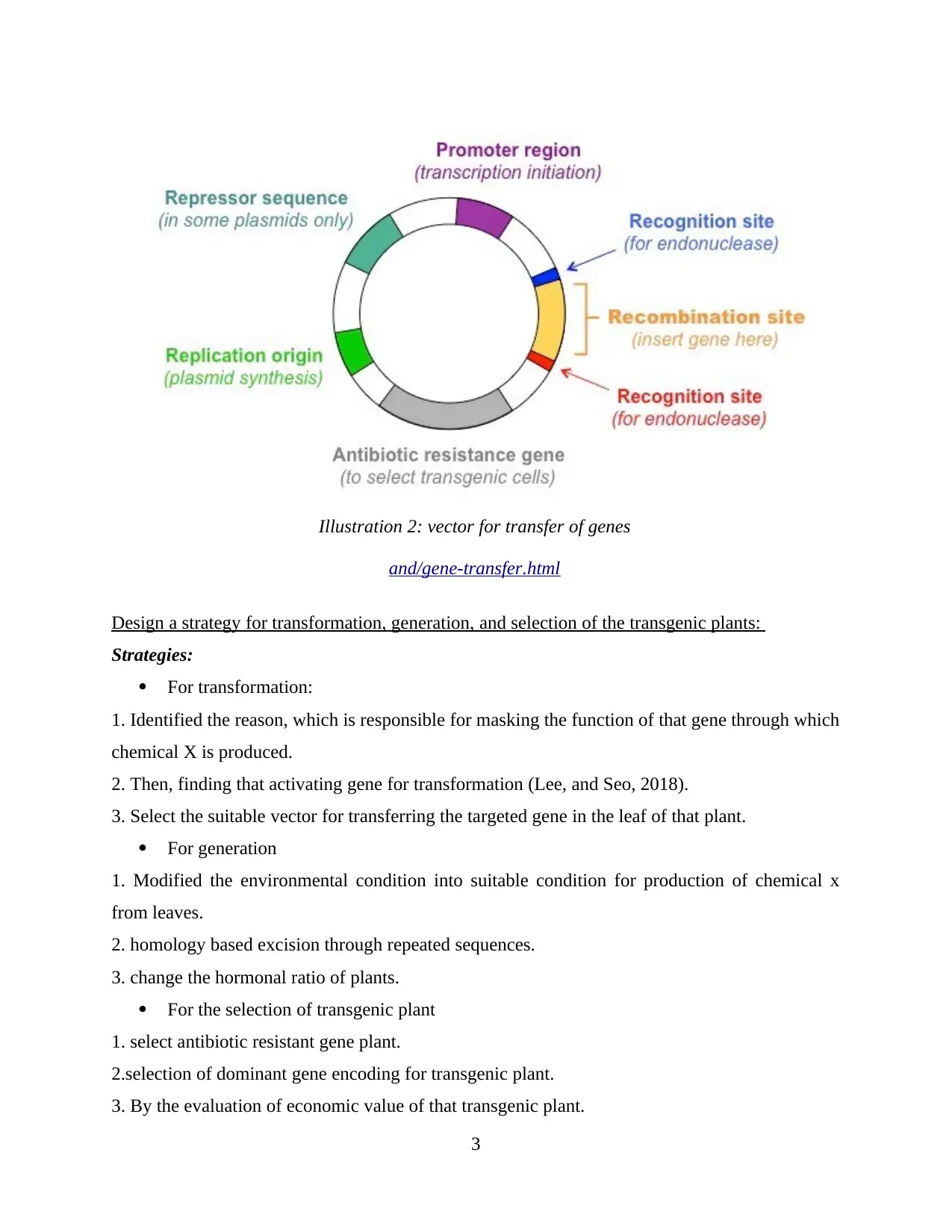
Design a strategy for transformation, generation, and selection of the transgenic plants:
Strategies:
For transformation:
1. Identified the reason, which is responsible for masking the function of that gene through which
chemical X is produced.
2. Then, finding that activating gene for transformation (Lee, and Seo, 2018).
3. Select the suitable vector for transferring the targeted gene in the leaf of that plant.
For generation
1. Modified the environmental condition into suitable condition for production of chemical x
from leaves.
2. homology based excision through repeated sequences.
3. change the hormonal ratio of plants.
For the selection of transgenic plant
1. select antibiotic resistant gene plant.
2.selection of dominant gene encoding for transgenic plant.
3. By the evaluation of economic value of that transgenic plant.
3
Illustration 2: vector for transfer of genes
and/gene-transfer.html
Strategies:
For transformation:
1. Identified the reason, which is responsible for masking the function of that gene through which
chemical X is produced.
2. Then, finding that activating gene for transformation (Lee, and Seo, 2018).
3. Select the suitable vector for transferring the targeted gene in the leaf of that plant.
For generation
1. Modified the environmental condition into suitable condition for production of chemical x
from leaves.
2. homology based excision through repeated sequences.
3. change the hormonal ratio of plants.
For the selection of transgenic plant
1. select antibiotic resistant gene plant.
2.selection of dominant gene encoding for transgenic plant.
3. By the evaluation of economic value of that transgenic plant.
3
Illustration 2: vector for transfer of genes
and/gene-transfer.html
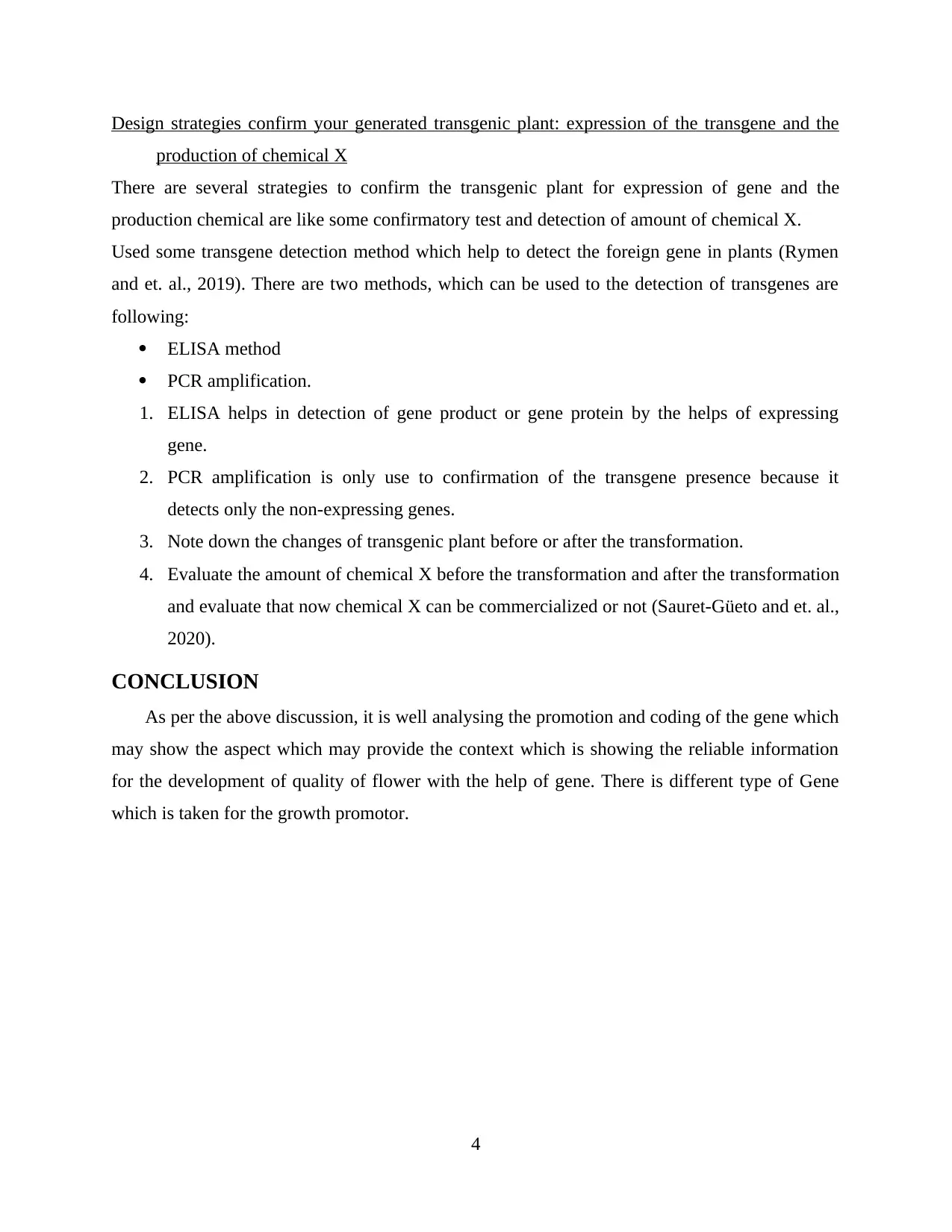
Design strategies confirm your generated transgenic plant: expression of the transgene and the
production of chemical X
There are several strategies to confirm the transgenic plant for expression of gene and the
production chemical are like some confirmatory test and detection of amount of chemical X.
Used some transgene detection method which help to detect the foreign gene in plants (Rymen
and et. al., 2019). There are two methods, which can be used to the detection of transgenes are
following:
ELISA method
PCR amplification.
1. ELISA helps in detection of gene product or gene protein by the helps of expressing
gene.
2. PCR amplification is only use to confirmation of the transgene presence because it
detects only the non-expressing genes.
3. Note down the changes of transgenic plant before or after the transformation.
4. Evaluate the amount of chemical X before the transformation and after the transformation
and evaluate that now chemical X can be commercialized or not (Sauret-Güeto and et. al.,
2020).
CONCLUSION
As per the above discussion, it is well analysing the promotion and coding of the gene which
may show the aspect which may provide the context which is showing the reliable information
for the development of quality of flower with the help of gene. There is different type of Gene
which is taken for the growth promotor.
4
production of chemical X
There are several strategies to confirm the transgenic plant for expression of gene and the
production chemical are like some confirmatory test and detection of amount of chemical X.
Used some transgene detection method which help to detect the foreign gene in plants (Rymen
and et. al., 2019). There are two methods, which can be used to the detection of transgenes are
following:
ELISA method
PCR amplification.
1. ELISA helps in detection of gene product or gene protein by the helps of expressing
gene.
2. PCR amplification is only use to confirmation of the transgene presence because it
detects only the non-expressing genes.
3. Note down the changes of transgenic plant before or after the transformation.
4. Evaluate the amount of chemical X before the transformation and after the transformation
and evaluate that now chemical X can be commercialized or not (Sauret-Güeto and et. al.,
2020).
CONCLUSION
As per the above discussion, it is well analysing the promotion and coding of the gene which
may show the aspect which may provide the context which is showing the reliable information
for the development of quality of flower with the help of gene. There is different type of Gene
which is taken for the growth promotor.
4
⊘ This is a preview!⊘
Do you want full access?
Subscribe today to unlock all pages.

Trusted by 1+ million students worldwide
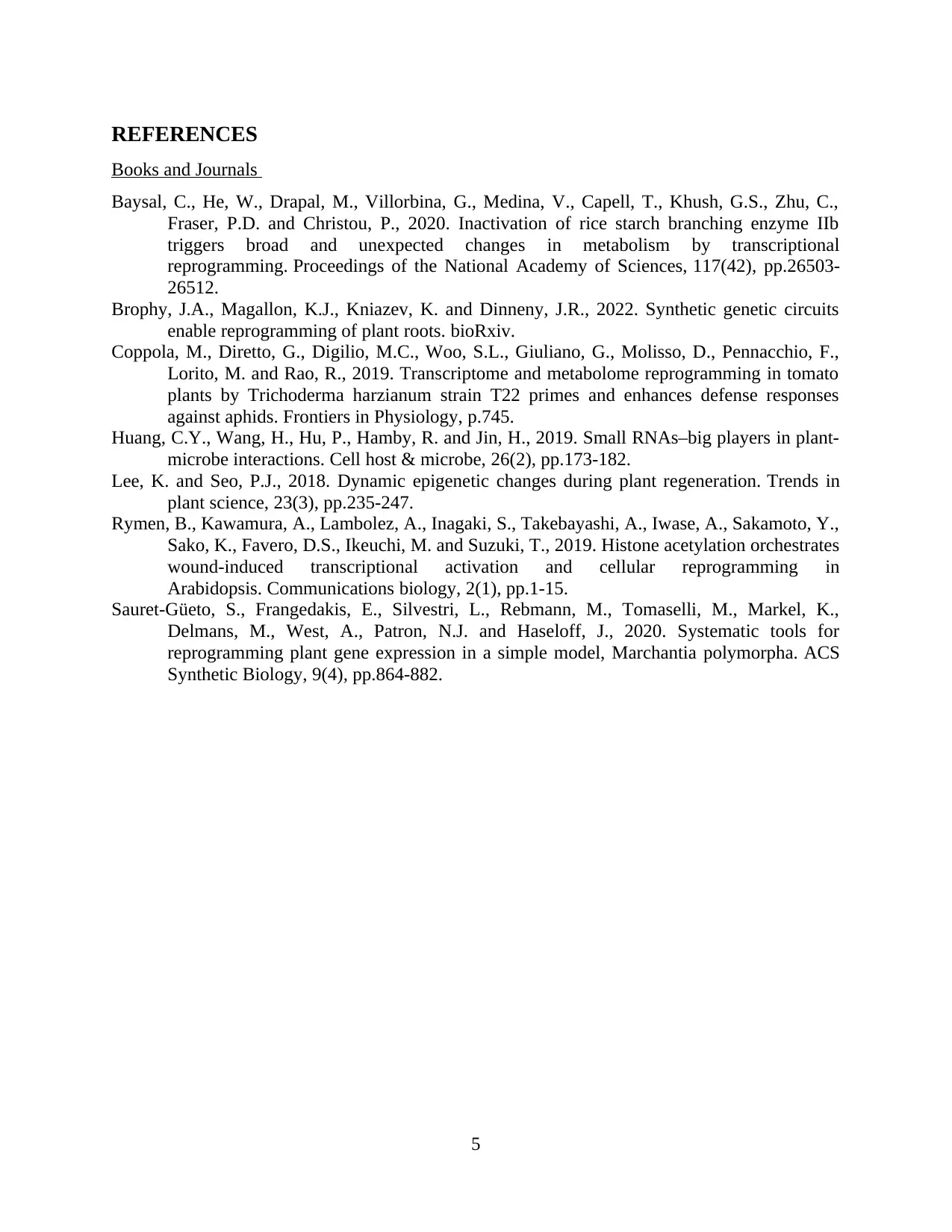
REFERENCES
Books and Journals
Baysal, C., He, W., Drapal, M., Villorbina, G., Medina, V., Capell, T., Khush, G.S., Zhu, C.,
Fraser, P.D. and Christou, P., 2020. Inactivation of rice starch branching enzyme IIb
triggers broad and unexpected changes in metabolism by transcriptional
reprogramming. Proceedings of the National Academy of Sciences, 117(42), pp.26503-
26512.
Brophy, J.A., Magallon, K.J., Kniazev, K. and Dinneny, J.R., 2022. Synthetic genetic circuits
enable reprogramming of plant roots. bioRxiv.
Coppola, M., Diretto, G., Digilio, M.C., Woo, S.L., Giuliano, G., Molisso, D., Pennacchio, F.,
Lorito, M. and Rao, R., 2019. Transcriptome and metabolome reprogramming in tomato
plants by Trichoderma harzianum strain T22 primes and enhances defense responses
against aphids. Frontiers in Physiology, p.745.
Huang, C.Y., Wang, H., Hu, P., Hamby, R. and Jin, H., 2019. Small RNAs–big players in plant-
microbe interactions. Cell host & microbe, 26(2), pp.173-182.
Lee, K. and Seo, P.J., 2018. Dynamic epigenetic changes during plant regeneration. Trends in
plant science, 23(3), pp.235-247.
Rymen, B., Kawamura, A., Lambolez, A., Inagaki, S., Takebayashi, A., Iwase, A., Sakamoto, Y.,
Sako, K., Favero, D.S., Ikeuchi, M. and Suzuki, T., 2019. Histone acetylation orchestrates
wound-induced transcriptional activation and cellular reprogramming in
Arabidopsis. Communications biology, 2(1), pp.1-15.
Sauret-Güeto, S., Frangedakis, E., Silvestri, L., Rebmann, M., Tomaselli, M., Markel, K.,
Delmans, M., West, A., Patron, N.J. and Haseloff, J., 2020. Systematic tools for
reprogramming plant gene expression in a simple model, Marchantia polymorpha. ACS
Synthetic Biology, 9(4), pp.864-882.
5
Books and Journals
Baysal, C., He, W., Drapal, M., Villorbina, G., Medina, V., Capell, T., Khush, G.S., Zhu, C.,
Fraser, P.D. and Christou, P., 2020. Inactivation of rice starch branching enzyme IIb
triggers broad and unexpected changes in metabolism by transcriptional
reprogramming. Proceedings of the National Academy of Sciences, 117(42), pp.26503-
26512.
Brophy, J.A., Magallon, K.J., Kniazev, K. and Dinneny, J.R., 2022. Synthetic genetic circuits
enable reprogramming of plant roots. bioRxiv.
Coppola, M., Diretto, G., Digilio, M.C., Woo, S.L., Giuliano, G., Molisso, D., Pennacchio, F.,
Lorito, M. and Rao, R., 2019. Transcriptome and metabolome reprogramming in tomato
plants by Trichoderma harzianum strain T22 primes and enhances defense responses
against aphids. Frontiers in Physiology, p.745.
Huang, C.Y., Wang, H., Hu, P., Hamby, R. and Jin, H., 2019. Small RNAs–big players in plant-
microbe interactions. Cell host & microbe, 26(2), pp.173-182.
Lee, K. and Seo, P.J., 2018. Dynamic epigenetic changes during plant regeneration. Trends in
plant science, 23(3), pp.235-247.
Rymen, B., Kawamura, A., Lambolez, A., Inagaki, S., Takebayashi, A., Iwase, A., Sakamoto, Y.,
Sako, K., Favero, D.S., Ikeuchi, M. and Suzuki, T., 2019. Histone acetylation orchestrates
wound-induced transcriptional activation and cellular reprogramming in
Arabidopsis. Communications biology, 2(1), pp.1-15.
Sauret-Güeto, S., Frangedakis, E., Silvestri, L., Rebmann, M., Tomaselli, M., Markel, K.,
Delmans, M., West, A., Patron, N.J. and Haseloff, J., 2020. Systematic tools for
reprogramming plant gene expression in a simple model, Marchantia polymorpha. ACS
Synthetic Biology, 9(4), pp.864-882.
5
1 out of 7
Your All-in-One AI-Powered Toolkit for Academic Success.
+13062052269
info@desklib.com
Available 24*7 on WhatsApp / Email
![[object Object]](/_next/static/media/star-bottom.7253800d.svg)
Unlock your academic potential
Copyright © 2020–2025 A2Z Services. All Rights Reserved. Developed and managed by ZUCOL.


